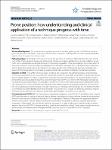Thông tin tài liệu
Thông tin siêu dữ liệu biểu ghi
| Trường DC | Giá trị | Ngôn ngữ |
|---|---|---|
| dc.contributor.author | Luciano, Gattinoni | - |
| dc.contributor.author | Serena, Brusatori | - |
| dc.contributor.author | Rosanna, D’Albo | - |
| dc.date.accessioned | 2023-03-16T04:17:35Z | - |
| dc.date.available | 2023-03-16T04:17:35Z | - |
| dc.date.issued | 2023 | - |
| dc.identifier.uri | https://link.springer.com/article/10.1007/s44254-022-00002-2 | - |
| dc.identifier.uri | https://dlib.phenikaa-uni.edu.vn/handle/PNK/6921 | - |
| dc.description | CC BY | - |
| dc.description.abstract | The findings in CT scans enhanced the use of prone position in ARDS patients. The main mechanism of the improved gas exchange seen in the prone position is nowadays attributed to a dorsal ventilatory recruitment, with a substantially unchanged distribution of perfusion. Regardless of the gas exchange, the primary effect of the prone position is a more homogenous distribution of ventilation, stress and strain, with similar size of pulmonary units in dorsal and ventral regions. In contrast, in the supine position the ventral regions are more expanded compared with the dorsal regions, which leads to greater ventral stress and strain, induced by mechanical ventilation. | vi |
| dc.language.iso | en | vi |
| dc.publisher | Springer | vi |
| dc.subject | Prone position | - |
| dc.subject | technique progres | - |
| dc.title | Prone position: how understanding and clinical application of a technique progress with time | vi |
| dc.type | Book | vi |
| Bộ sưu tập | ||
| OER- Y học- Điều dưỡng | ||
Danh sách tệp tin đính kèm:

